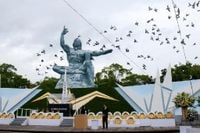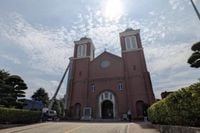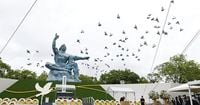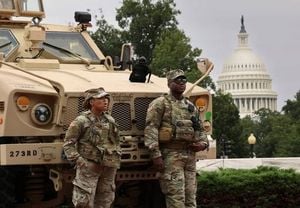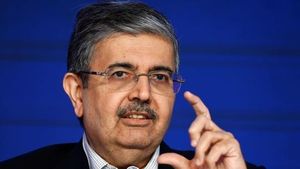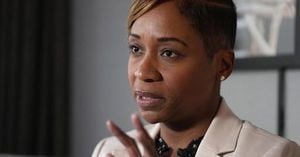At precisely 11:02 a.m. on August 9, 1945, a moment of unfathomable destruction unfolded over Nagasaki, Japan. The United States’ B-29 bomber “Bockscar” released a plutonium nuclear bomb, instantly erasing entire neighborhoods and killing an estimated 74,000 people. Just three days prior, the world had already witnessed the horror of nuclear warfare when the “Enola Gay” dropped a uranium bomb on Hiroshima, resulting in the immediate deaths of some 90,000 people. The bombings of Hiroshima and Nagasaki marked the first and only use of nuclear weapons in warfare, forever altering the course of history and casting a shadow that endures even 80 years later.
As the world commemorates the 80th anniversary of the Nagasaki bombing on August 9, 2025, the scars of those days remain vivid. Survivors, known as hibakusha, continue to bear the invisible wounds of radiation exposure—leukemia, cancers, and a host of other illnesses that have haunted them for decades. According to the NKyTribune, the basic facts of these bombings are widely known, yet the stories of many victims—Americans, Koreans, Japanese Americans, and others—have long remained in the shadows.
The pilot of the “Enola Gay,” then-Colonel Paul Tibbets, was a young man from Quincy, Illinois, who had once studied medicine at the University of Cincinnati before enlisting in the armed forces at Fort Thomas Military Reservation in Northern Kentucky. His fateful mission over Hiroshima on August 6, 1945, changed the world forever. But the devastation was not limited to Japanese civilians. Among the dead in Hiroshima were twelve American prisoners of war (POWs), their fate largely unknown to the American public for decades.
It was the tireless work of Japanese historian Shigeaki Mori, himself a survivor of the Hiroshima blast at just eight years old, that finally brought these forgotten POWs into the light. Mori’s decades-long search uncovered the names and stories of the American victims, culminating in a memorial at Hiroshima Peace Memorial Park. On May 27, 2016, Mori met then-President Barack Obama during the first-ever visit by a sitting U.S. president to Hiroshima, a powerful moment of recognition and remembrance. As PBS NewsHour reported, Mori’s journey is also captured in the documentary “Paper Lanterns.”
Five of the twelve American POWs killed in Hiroshima hailed from the Ohio River watershed, including Staff Sergeant Ryan J. Neal of Kentucky, Staff Sergeant Charles O. Baumgartner of Ohio, Captain John A. Long, Jr. of Pennsylvania, First Lieutenant Joseph E. Dubinsky of Pennsylvania, and Lieutenant Raymond Porter of Pennsylvania. Their stories, once hidden by military secrecy, now serve as a somber reminder of the bomb’s indiscriminate reach.
Nagasaki, too, held its own share of tragedies. Although a major POW camp on the city’s outskirts was spared the direct impact of the blast, many Allied prisoners—especially Dutch and British—were incarcerated there, their fates intertwined with the city’s suffering. As The Asahi Shimbun noted, Nagasaki was Japan’s most international city at the time, home to many foreigners who became victims or survivors of the attack.
The bombings also claimed the lives of thousands of Koreans and Chinese who were living or working in Hiroshima and Nagasaki. Scholar Kurt W. Tong estimates that over 400,000 people—including Japanese, Koreans, Chinese, and a handful of American prisoners—were exposed to the Hiroshima blast and its radioactive aftermath. Among the Korean hibakusha, between 48,000 and 50,000 were affected, with about 30,000 dying immediately or within a year. The Nagasaki bombing left at least 10,000 Koreans dead, with countless others suffering for years afterward.
Japanese Americans, too, were caught in the maelstrom. As many as 11,000 were in Hiroshima in August 1945, some stranded by the outbreak of war, others sent by their families to reconnect with their heritage. After the war, about 3,000 returned to the United States, but they faced daunting challenges—ongoing health problems, difficulties reacclimating to American life, and even struggles to regain fluency in English. According to Denshō, the U.S. government has yet to fully recognize these atomic victims and survivors.
The scale of devastation wrought by the atomic bombings is almost impossible to fathom. World War II itself claimed around eighty million lives worldwide, both military and civilian, as reported by Paul A. Tenkotte, PhD, in the NKyTribune. Yet, the atomic victims and survivors of Hiroshima and Nagasaki occupy a unique place in history—symbols of both the horror of nuclear warfare and the resilience of the human spirit.
On this 80th anniversary, Nagasaki’s bells rang in unison for the first time since that fateful day, and water was offered in tribute to the victims—a poignant echo of the cries for water from those suffering in 1945. Survivor Hiroshi Nishioka, now 93, recalled from his vantage point three kilometers from the blast how even those who initially seemed spared soon began to bleed from their gums, lose their hair, and die one after another. His testimony, shared in NKyTribune and echoed in PBS NewsHour, underscores the enduring trauma of that day.
United Nations Secretary-General António Guterres, in a solemn message delivered to the Nagasaki Peace Memorial, called the hibakusha’s testimony “an eternal moral compass for our world.” As the number of living survivors dwindles, their warnings grow more urgent. “Nuclear weapons bring no safety, only annihilation,” Guterres declared, urging the world not to let their lessons fade into history.
Despite the passage of eight decades, the threat of nuclear weapons has not receded. As reported by NKyTribune and reiterated by PBS NewsHour, the first resolution ever passed by the United Nations in 1946 called for the elimination of nuclear arms. Yet in 2025, nuclear weapons remain central to national security doctrines, and global military spending has reached record highs while funding for peace and development lags far behind.
Still, there are glimmers of hope. In 2024, the Japanese organization Nihon Hidankyo, representing the survivors of Hiroshima and Nagasaki, was awarded the Nobel Peace Prize for its decades of advocacy. That same year, United Nations Member States adopted the Pact for the Future, recommitting to a world free of nuclear weapons. But as Guterres and others have emphasized, recommitment without concrete action is merely hollow rhetoric.
Experts and advocates now call for a renewed push to strengthen the global nuclear non-proliferation regime—anchored by the Treaty on the Non-Proliferation of Nuclear Weapons (NPT) and the Treaty on the Prohibition of Nuclear Weapons (TPNW). This includes reviving disarmament diplomacy, restoring moratoriums on nuclear testing, achieving universal ratification of the Comprehensive Nuclear-Test-Ban Treaty, reducing nuclear stockpiles through verifiable agreements, and replacing outdated doctrines of deterrence with genuine commitments to abolition.
The hibakusha, the victims of Semipalatinsk, and all those who have suffered under the nuclear shadow share a warning that echoes through the decades. As the world marks 80 years since the devastation of Nagasaki, the choice remains as stark as it was in 1945: continue to live under the threat of annihilation, or step into the light of a future free from nuclear weapons. The moment to choose, as so many survivors have urged, is now.
